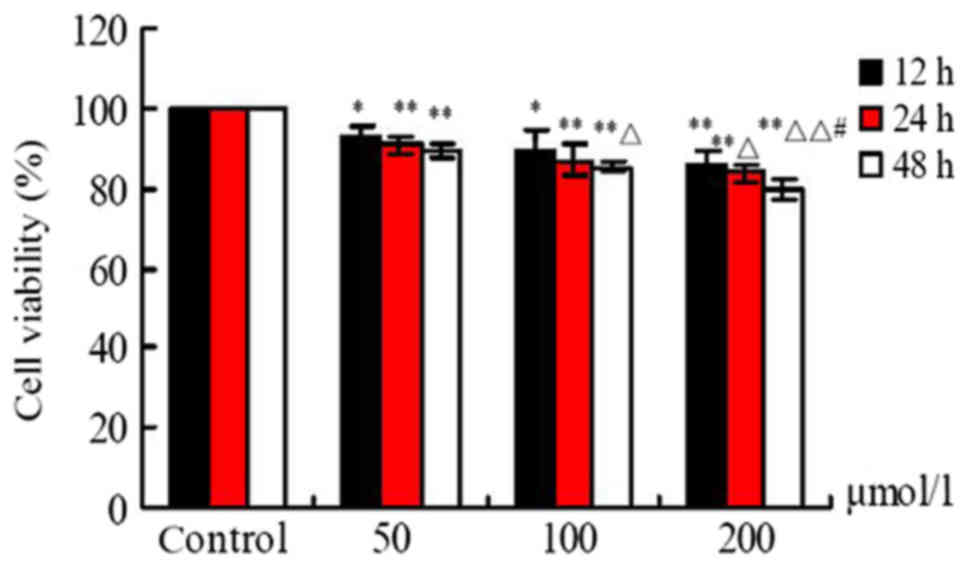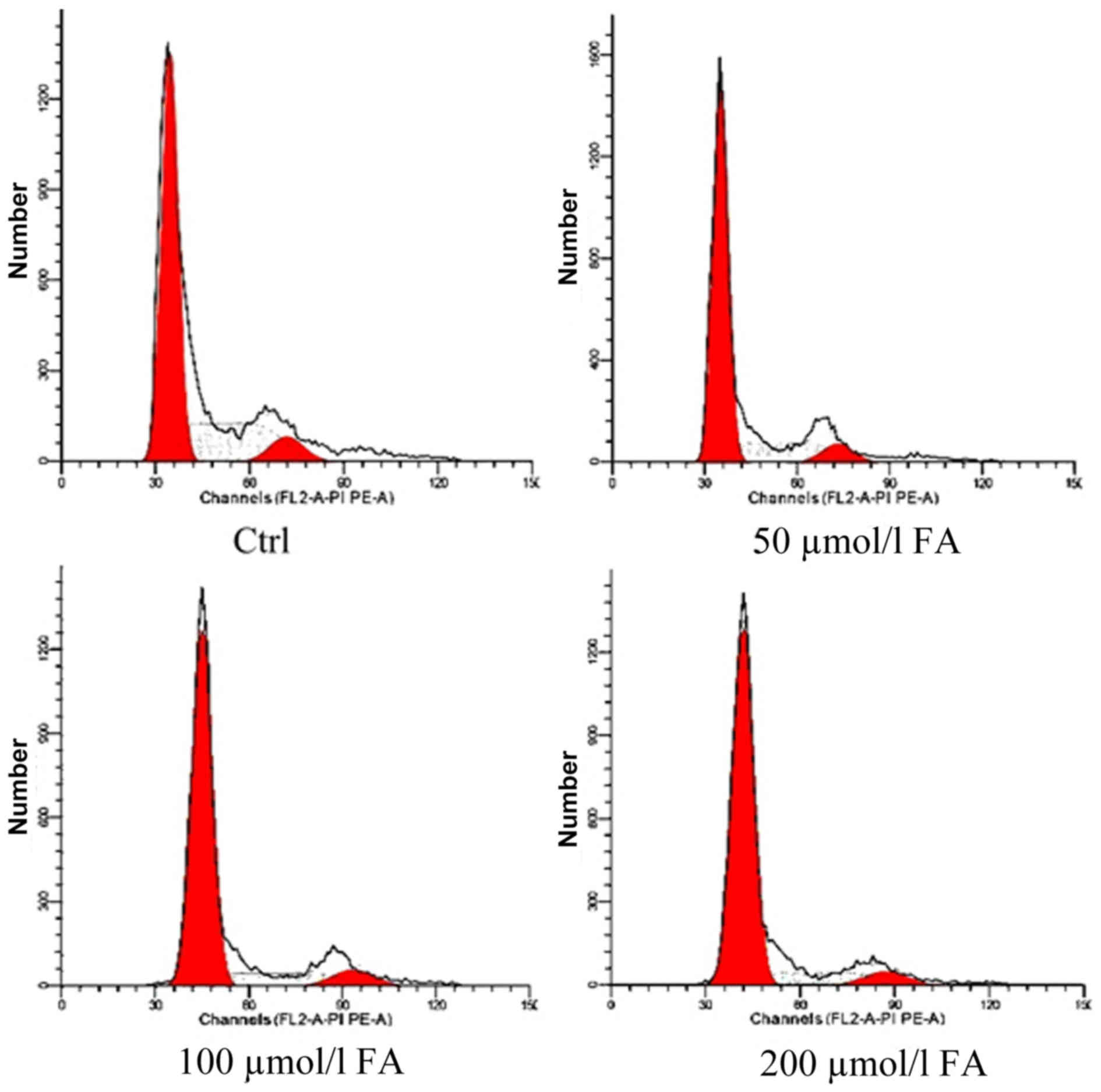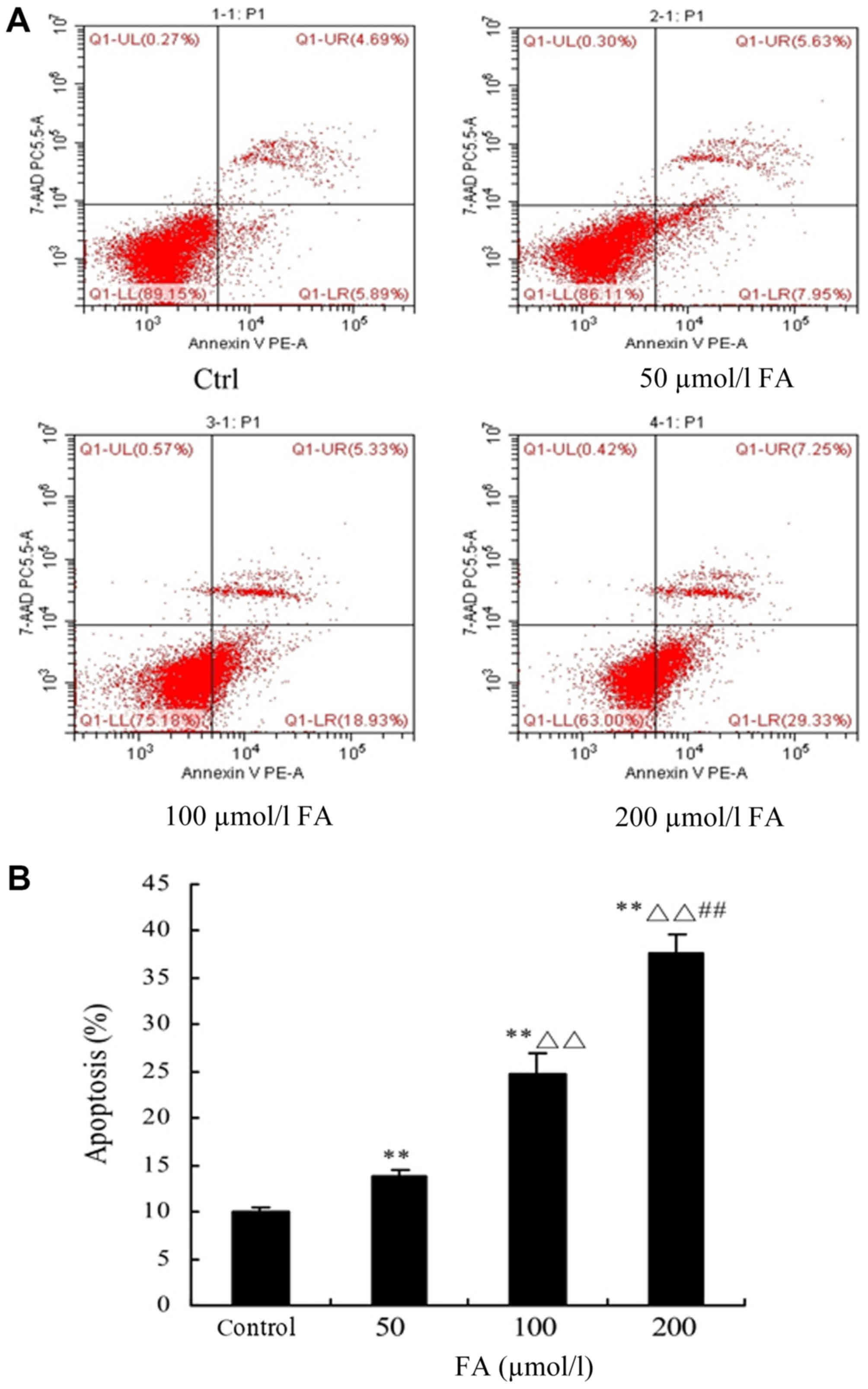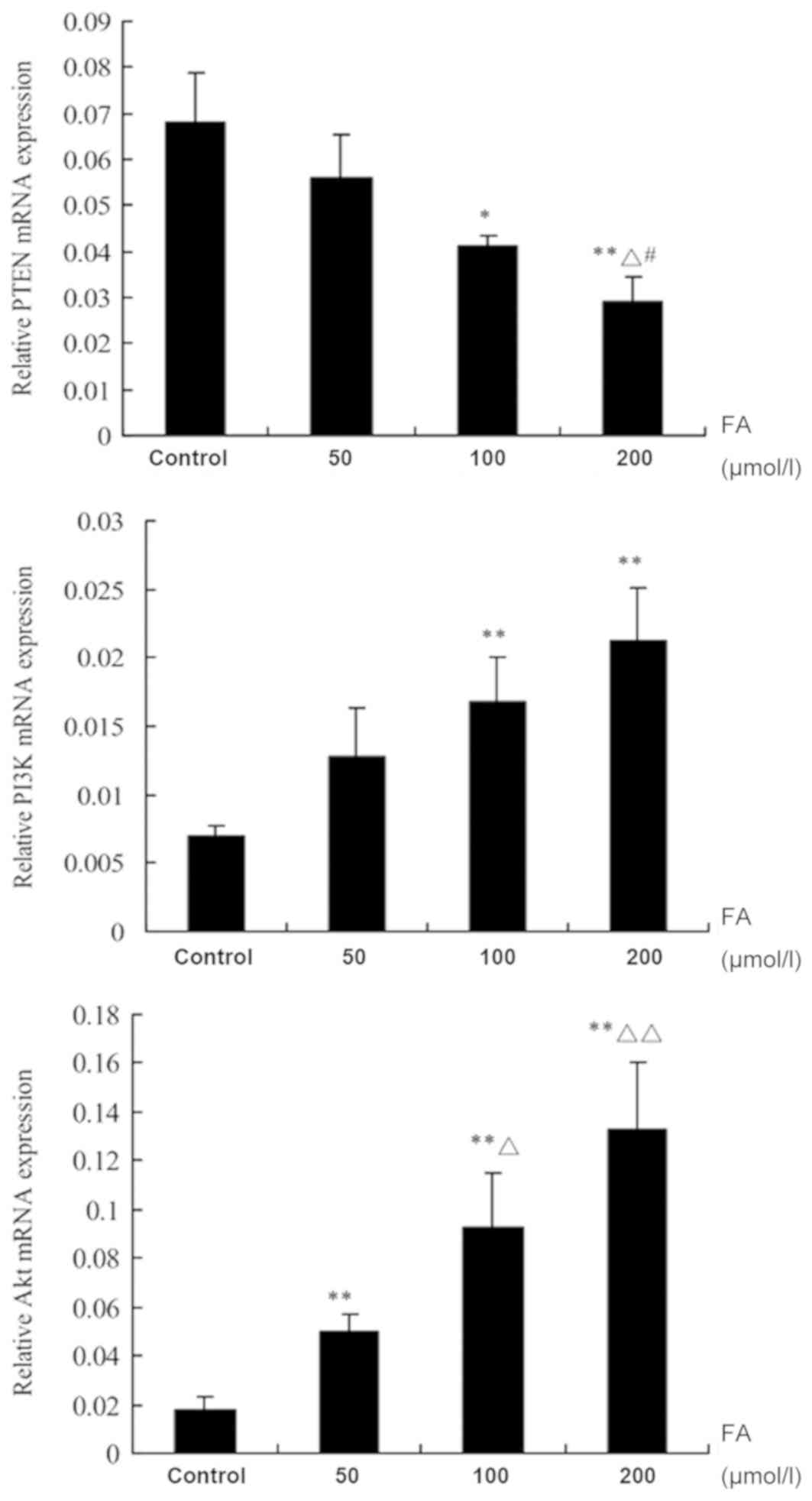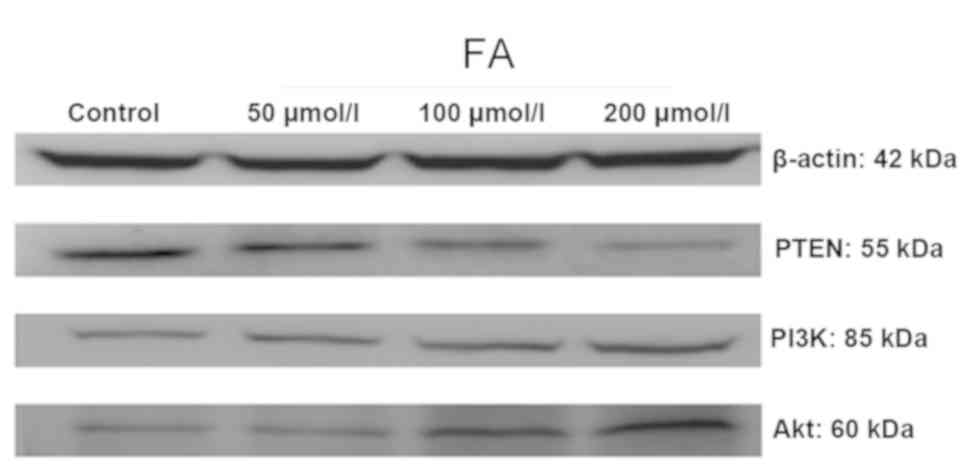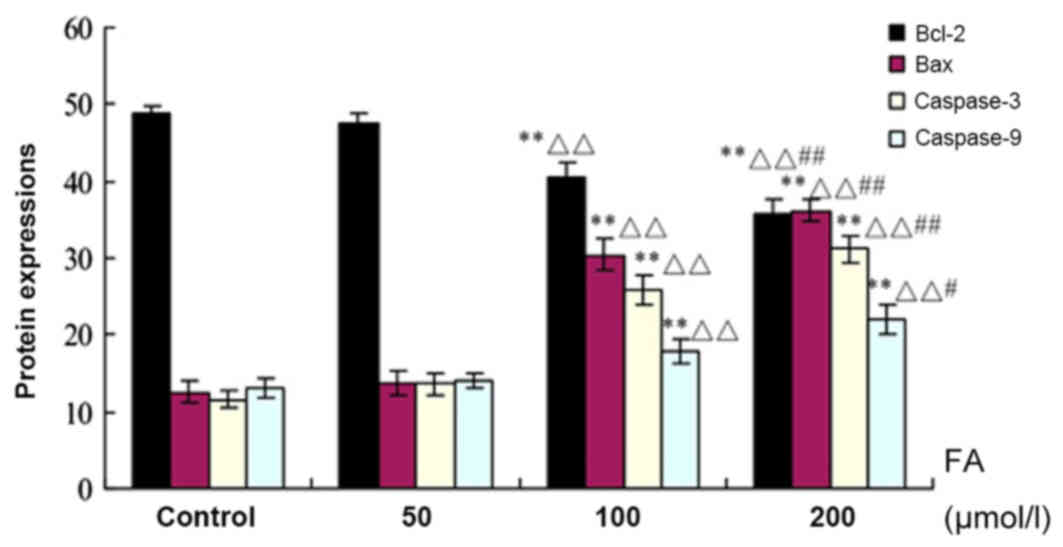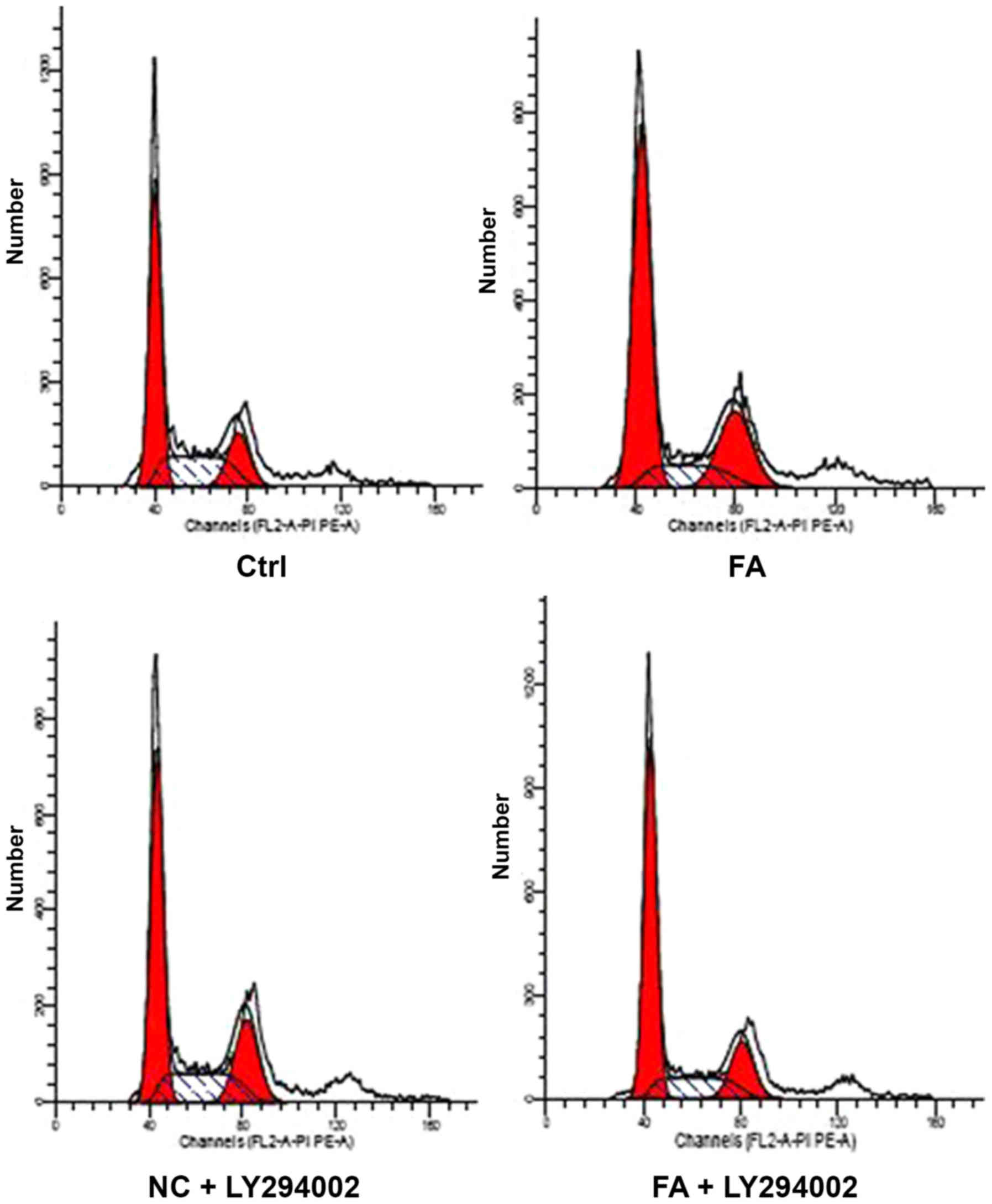Formaldehyde induces the apoptosis of BMCs of BALB/c mice via the PTEN/PI3K/Akt signal transduction pathway
- Authors:
- Published online on: May 9, 2019 https://doi.org/10.3892/mmr.2019.10227
- Pages: 341-349
-
Copyright: © Yu et al. This is an open access article distributed under the terms of Creative Commons Attribution License.
Abstract
Introduction
Formaldehyde (FA) is hematotoxic to humans and mice (1), and has been classified as a human leukemogen by the International Agency for Research on Cancer (2) and the U.S. National Toxicology Program (3); however, the exact mechanism remains unclear. The bone marrow (BM) is the site of blood cell generation from hematopoietic stem cells, as well as the target site for the induction of leukemia (4). Numerous studies have investigated the toxicity of FA; however, few investigations into the effects of FA on the BM have been conducted.
Phosphatase and tensin homologue deleted on chromosome 10 (PTEN) was the first phosphatase identified as a tumor suppressor gene and has been considered as a negative regulator of the phosphoinositide 3-kinase (PI3K)/protein kinase B (Akt) signaling pathway, which modulates the cell cycle, apoptosis and differentiation (5,6). Additionally, PTEN is expressed at low levels in leukemia cells, and can regulate the invasive ability and angiogenesis of these cells (7). Downregulated PTEN can lead to the abnormal expression of proteins involved in the PI3K/Akt signaling pathway, and induce malignant diseases of the blood (8,9). PI3K is the initiator of PI3K/Akt signaling pathway, which regulates the proliferation and survival of tumor cells, and serves an important role in the onset of leukemia (10). The abnormal activity of PI3K not only induces the malignant transformation of cells, but is also associated with the migration and adhesion of tumor cells, as well as the degradation of extracellular matrix (11). Akt is the direct target protein of PI3K, and can activate or inhibit numerous downstream signaling molecules, including B-cell lymphoma 2 (Bcl-2), Bcl-2-associated X (Bax), mammalian target of rapamycin (mTOR) and Caspase-9 (12,13). At present, no studies into the association between FA and the PTEN/PI3K/Akt signal transduction pathway in bone marrow cells (BMCs) have been conducted. Therefore, the aim of the present study was to determine whether FA could induce the apoptosis of BMCs via the PTEN/PI3K/Akt signal transduction pathway, so as to investigate the potential mechanism underlying the progression of leukemia. Our results may provide an experimental basis for future studies into the mechanisms of FA toxicity and the prevention of leukemia.
Materials and methods
Reagents
Dulbecco's Modified Eagle's medium (DMEM) and fetal bovine serum were purchased from Gibco (Thermo Fisher Scientific, Inc., Waltham, MA, USA). Tryptase and 100X penicillin/streptomycin mixing liquid were purchased from Beyotime Institute of Biotechnology (Shanghai, China). FA (36.5–38% in water, formula weight, 30.03), a Cell Counting Kit 8 (CCK-8) assay kit, ethidium iodide and RNA enzymes were purchased from Sigma-Aldrich (Merck KGaA, Darmstadt, Germany). An apoptosis analysis kit was purchased from BD Biosciences (San Jose, CA, USA). Antibodies against PTEN (cat. no. sc-7974), PI3K (cat. no. sc-374534), Akt (cat. no. sc-5298), Bcl-2 (cat. no. sc-7382), Bax (cat. no. sc-20067), and Caspases-3 (cat. no. sc-56053) and −9 (cat. no. sc-73548) were purchased from Santa Cruz Biotechnology, Inc. (Dallax, TX, USA). All reagents were of the highest purity commercially available.
Animals and treatment
A total of 30BALB/c mice (specific-pathogen free, male, 6–8-weeks-old, 18–20 g) were purchased from the Experimental Animal Center of Chongqing Medical University (Chongqing, China, license no. SCXK-Yu 2012-0001), and housed under standard laboratory conditions (temperature: 20–25°C; relative humidity: 50–70%; 12 h light dark cycle). Food and water were provided ad libitum. All animal experiments were conducted in accordance with the National Institutes of Health Guide for the Care and Use of Laboratory Animals (14) and were approved by the Ethics Committee of Jilin University (Changchun, China).
Cell culture
Following sacrifice of the BALB/c mice, the femurs were harvested and the surrounding tissues were removed. Then, an incision was made on the greater trochanter and the samples were washed twice with 0.01 mol/l PBS; 1-ml sterile syringes were used to wash the BMCs. This process was repeated until the cells were completely removed from the femur samples. Subsequently, BMCs were filtered with a 200-mesh nylon filter to obtain a single bone marrow cell suspension. The cells were washed with 0.01 mol/l PBS, resuspended in DMEM and counted using a cell counter (Bio-Rad Laboratories, Inc., Hercules, CA, USA) for subsequent analysis.
Cell viability assay
The cell viability assay was performed using a CCK-8 assay kit according to the manufacturer's protocols. BMCs were seeded in 96-well plates with a density of 1×105 cells/ml, and exposed to various doses of FA (50, 100 and 200 µmol/l) for 12, 24 and 48 h at 37°C in an incubator with 5% CO2; untreated cells served as the control (Ctrl) group. Additionally, a blank group containing medium only with no cells was also included. The cells (untreated and treated with FA) and the blank group were then incubated with 10 µl of the CCK-8 solution for 1.5 h at 37°C in an incubator with 5% CO2. Then, the number of viable cells in each well was counted by measuring the absorbance at a wavelength of 450 nm with a microplate reader (Thermo Fisher Scientific, Inc.).
Cell viability (%) = [A (experimental group) - A (blank group)]/[A (Ctrl group) - A (blank group)] ×100%.
Cell cycle assay
Following treatment with various doses of FA (50, 100 and 200 µmol/l) for 24 h at 37°C in an incubator with 5% CO2, BMCs were washed twice with 0.01 mol/l pre-cooled PBS. Then, the cells were fixed overnight in pre-cooled 70% ethanol at 4°C; 100 µl RNase (10 µg/ml) and 100 µl propidium iodide (5 µg/ml) were added to cells. The cells were incubated without light for 30 min at 37°C. The cell cycle was measured with a flow cytometer (FACSVantage SE; BD Biosciences) and data were analyzed using Cell Quest software (version 5.1; BD Biosciences).
Cell cycle assay following PI3K inhibitor treatment
The cells were divided into the Ctrl, FA, negative control (NC; untreated cells) + LY294002 and FA + LY294002 groups; 10 µmol/l LY294002 (Santa Cruz Biotechnology, Inc.) was added into the inhibitor treatment groups and 100 µmol/l FA was selected for treatment. Then, the cells were incubated for 24 h at 37°C in an incubator with 5% CO2. Analysis of the cell cycle was conducted as aforementioned.
Determination of cell apoptosis by flow cytometry (FCM)
Following BMC exposure to different doses of FA (50, 100 and 200 µmol/l) for 24 h, cells were collected and centrifuged at 800 × g for 5 min at room temperature; the cells were then washed twice with 0.01 mol/l PBS, and centrifuged at 800 × g for 5 min at room temperature. A total of 1×105 cells were collected, to which 5 µl 7-aminoactinomycin D dye solution was added. The cells were incubated in the dark at room temperature for 15 min. Subsequently, 450 µl Binding Buffer (BD Biosciences) was applied, followed by 1 µl Annexin V-phycoerythrin; cells were incubated at room temperature for 15 min. Cell apoptosis was measured by FCM (FACSVantage SE) and data were analyzed using Cell Quest software.
Expression of PTEN, PI3K and Akt as analyzed by reverse transcription-quantitative polymerase chain reaction (RT-qPCR)
BMCs were divided into the Ctrl and various FA-treatment groups (50, 100 and 200 µmol/l). Cells were treated with FA for 24 h and the total RNA was extracted using TRIzol® reagent (Thermo Fisher Scientific, Inc.). PrimeScript™ RT reagent (Takara Biotechnology, Co., Ltd., Dalian, China) was used to reverse transcribe RNA samples into cDNA under the following conditions: 25°C for 10 min, 42°C for 50 min and 85°C for 5 min. Based on the sequence complementarity of the cDNA template to the upstream and downstream primers of target genes, cDNA was used for qPCR. The mRNA expression levels were determined using an SYBR® Premix Ex Taq™ kit (Takara Biotechnology Co., Ltd.) on an FTC-3000 system (Funglyn Bio Inc., Toronto, Canada). qPCR was conducted as follows: 35 cycles of 94°C for 20 sec, 60°C for 30 sec and 72°C for 30 sec. The primers of PTEN, PI3K and Akt employed in the present study were designed as follows: PTEN, forward 5′-AAGACCATAACCCACCACAGC-3′, reverse, 5′-CCAGTCCGTCCCTTTCCAG-3′ (amplicon size: 124 bp); PI3K, forward 5′-AAGCCATTGAGAAGAAAGGACTG-3′, reverse, 5′-ATTTGGTAAGTCGGCGAGATAG-3′ (amplicon size: 176 bp); and Akt, forward 5-TGT CTG CCC TGG ACT ACT TGC-3′ and reverse, 5′-GGCGTTCCGCAGAATGTC-3′ (amplicon size: 166 bp). β-actin served as the internal reference (forward, 5′-GAGACCTTCAACACCCCAGC-3′ and reverse, 5′-ATGTCACGCACGATTTCCC-3′; amplicon size: 263 bp). The relative expression (2−∆∆Cq) (15) of PTEN, PI3K and Akt was calculated as follows:
Relative expression = 2−∆∆Cq; DCq = Cq PTEN/PI3K/Akt - Cqβ-actin.
Expression of PTEN, PI3K and Akt via western blot analysis
BMCs were divided into the Ctrl and various FA-treatment groups (50, 100 and 200 µmol/l). Following treatment with FA for 24 h, the protein in BMCs was extracted using a Protein Extraction kit (Beyotime Institute of Biotechnology), and the protein level was determined using a BCA Protein Assay kit (Beyotime Institute of Biotechnology). Then, equal amounts of protein (35 µg) were separated via 12% SDS-PAGE and transferred to polyvinylidene difluoride membranes via electroblotting. The membranes were blocked with 5% non-fat dried milk in 1X TBST buffer (pH 7.6; 2.42 g Tris base, 8.0 g NaCl, 1,000 ml ddH2O and 0.5 ml Tween-20) for 1.5 h at room temperature. Subsequently, the membranes were incubated with primary polyclonal antibodies, at a dilution of 1:1,000 for β-actin (cat. no. sc-47778; Santa Cruz Biotechnology, Inc.), and 1:500 for PTEN, PI3K and Akt for 1.5 h at room temperature. Then, the membranes were washed three times with TBST, and incubated for 1.5 h at room temperature with a horseradish peroxidase-conjugated goat anti-mouse immunoglobulin G (IgG) secondary antibody (1:1,000; cat. no. sc-2005; Santa Cruz Biotechnology, Inc.). The protein bands were visualized using an enhanced chemiluminescence detection system (Tannon Science & Technology, Co., Ltd., Shanghai, China), and an Image analysis system (Labworks™ analysis software, Labworks LLC, Lehi, UT, USA).
Expression of Bcl-2, Bax, and Caspases-3 and −9 via immunohistochemistry
BMCs were collected and divided into the Ctrl and various FA-treatment groups (50, 100 and 200 µmol/l). Following treatment with FA for 24 h, the cells of each group were conventionally smeared onto slides. Following fixation with formalin buffer solution 10% for 15 min at room temperature, the slides were air dried and then stored in a refrigerator at −20°C. The slides were treated with 3% H2O2 for 15 min at room temperature, washed with 0.01 mol/l PBS three times, and then blocked with 10 µl 10% non-immune mouse serum (Abbkine Scientific Co., Ltd., Lake Bluff, IL, USA) for 15 min at room temperature. Subsequently, slides were incubated with primary antibodies against Bcl-2, Bax, Caspases-3 and −9 (all 1:100; Santa Cruz Biotechnology, Inc.) overnight at 4°C. After washing with PBS three times, the slides were incubated with horseradish peroxidase-conjugated goat anti-mouse IgG secondary antibody (1:1,000; cat. no. L3032-2; Signalway Antibody LLC, College Park, MD, USA) for 15 min at room temperature. Following a further three washes with PBS, 10 µl of Streptomyces antibiotic protein-peroxidase solution (Beijing Zhongshan Golden Bridge Biotechnology Co, Ltd.; OriGene Technologies, Inc., Beijing, China) for 15 min at room temperature. The color reaction was performed with 3,3-diaminobenzidine (Beyotime Institute of Biotechnology), then slides were counterstained with hemotoxylin (Beyotime Institute of Biotechnology) for 2 min at room temperature. Subsequently, the slides were placed in 70% HCl-ethanol for 15 sec and washed in water, and then in weak ammonia for 15 sec. Slides were then dehydrated and mounted. Five random visual fields were observed using an Olympus BX-50 light microscope (magnification, ×200; Olympus Corporation, Tokyo, Japan); 100 cells were selected in each field. Cells with brown-yellow particles deposited on the membrane or nucleus were counted as positive cells, and the positive rate was calculated by the formula:
Positive staining (%) = Positive cells/cells ×100%.
Statistical analysis
Statistical analysis was performed using SPSS software v24.0 (IBM Corp., Armonk, NY, USA). All experiments were performed at least three times, and the data were expressed as the mean ± standard deviation. Significant differences between groups were determined by one-way analysis of variance followed by a Tukey's multiple comparison test. P<0.05 was considered to indicate a statistically significant difference.
Results
Effects of FA on cell viability
Following exposure to different doses of FA (50, 100 and 200 µmol/l) for 12, 24 and 48 h, cell viability was significantly reduced in response to increasing concentrations of FA compared with the Ctrl group. As presented in Fig. 1, FA suppressed the viability of BMCs in a dose- and time-dependent manner; a significant difference in cell viability was observed at 12, 24 and 48 h (P<0.05). In addition, a significant difference between the 200 and 50 µmol/l FA treatment groups at 24 and 48 h was reported (P<0.05), and compared with the 100 µmol/l group at 48 h (P<0.01; Fig. 1).
Effects of FA on the cell cycle
Following exposure to different doses of FA (50, 100 and 200 µmol/l) for 24 h, the proportion cells in G0/G1-phase increased with FA treatment, while the number of cells in S-phase was decreased. A significant difference in the number of cells in G0/G1 and S-phase following FA treatment was detected compared with the Ctrl group (P<0.01). Additionally, significant differences in the proportion of cells in G0/G1 and S-phase of the 100 and 200 µmol/l groups compared with the 50 µmol/l group were observed (P<0.01). The number of cells in S-phase significantly differed between the 200 and 100 µmol/l groups (P<0.05). The number of G2/M-phase cells in each group was markedly unaltered. These results demonstrated that FA may induce cell cycle arrest at G0/G1 phase in BMCs and alter cell proliferation to inhibit cell growth and development (Table I; Fig. 2).
Determination of cell apoptosis by FCM
Following treatment with different doses of FA (50, 100 and 200 µmol/l) for 24 h, FCM was conducted to detect apoptosis. The results demonstrated that the percentage of apoptotic cells was significantly increased with increasing concentrations of FA; significant increases were reported with FA treatment compared with the Ctrl group (P<0.01). Additionally, significant differences in the 100 and 200 µmol/l groups compared with the 50 µmol/l group were observed (P<0.01). Furthermore, a significant difference between the 200 and 100 µmol/l groups was reported (P<0.01; Fig. 3).
Determination of PTEN, PI3K and Akt expression by RT-qPCR
Following treatment with different doses of FA (50, 100 and 200 µmol/l) for 24 h, the mRNA expression levels of PTEN were notably suppressed with increasing concentrations of FA; significant decreases in the 100 and 200 µmol/l groups were observed compared with the Ctrl (P<0.05). Additionally, significant differences following treatment with 200 µmol/l FA were detected compared with 50 and 100 µmol/l FA (P<0.05). The mRNA expression levels of PI3K were upregulated with increasing concentrations of FA; significant increases in expression following treatment with 100 and 200 µmol/l FA were reported compared with the Ctrl (P<0.01). The mRNA expression levels of Akt were also upregulated in response to increasing concentrations of FA; significant increases between the FA treatment groups and the Ctrl were observed (P<0.01). In addition, there were significant differences in Akt expression following treatment with 100 and 200 µmol/l FA compared with 50 µmol/l FA (P<0.05; Fig. 4).
Determination of PTEN, PI3K and Akt protein expression by western blot analysis
As presented in Fig. 5, following treatment with different doses of FA (50, 100 and 200 µmol/l) for 24 h, the expression levels of PTEN protein were decreased, whereas the protein expression levels of PI3K and Akt were upregulated with increasing concentrations of FA.
Bcl-2, Bax, and Caspases-3 and −9 protein expression as determined by immunohistochemistry
As presented in Fig. 6, the expression levels of Bax, and Caspases-3 and −9 protein were upregulated with increasing concentrations of FA, while the expression of Bcl-2 was decreased. There were significant increases in the expression levels of the aforementioned proteins in response to 100 and 200 µmol/l FA compared with the Ctrl (P<0.01). In addition, significant increases in the 100 and 200 µmol/l FA groups were reported compared with the 50 µmol/l FA group (P<0.01); a significant difference between the 200 and 100 µmol/l FA groups was also observed (P<0.05).
Determination of the cell cycle by FCM following treatment with LY294002
The BMCs were divided into Ctrl, FA, NC + LY294002 and FA + LY294002 groups. After 24 h of FA (100 µmol/l) treatment, the proportion of cells in S-phase in the FA, NC + LY294002 and FA + LY294002 groups decreased compared with the Ctrl group (P<0.01), whereas the number of cells in G0/G1 in the FA and FA + LY294002 groups was significantly increased (P<0.01); however, there was no notable alteration in the number of cells in G0/G1 in the NC + LY294002 group compared with the Ctrl. Additionally, the proportion of cells in G2/M-phase in the NC + LY294002 and FA groups was also significantly increased compared with the Ctrl group (P<0.01), whereas there was no difference between the FA + LY294002 and Ctrl groups. Furthermore, compared with the NC + LY294002 group, significant differences were observed in the FA and FA + LY294002 groups in the number of cells in G0/G1 and S-phase (P<0.01), whereas the number of cells in G2/M-phase increased in the FA group (P<0.05) and decreased in the FA + LY294002 group (P<0.01). It was also observed that the proportion of cells in S- and G2/M-phase significantly varied in FA+ LY294002 group compared with the FA group (P<0.01); however, there was no change in G0/G1-phase (Table II; Fig. 7). The results suggested that FA may alter cell proliferation and induce G0/G1-phase arrest. After using a PI3K inhibitor to block the PTEN/PI3K/Akt signaling pathway, it was observed that the proportion of cells in S-phase increased compared with FA group, whereas that in G2/M-phase decreased, indicating that DNA synthesis in cells was increased, and that the cell cycle was arrested in S-phase.
Discussion
PTEN, as a tumor-suppressing gene, is widely expressed in numerous tissues and organs of the human body (16). It can regulate apoptosis, participate in oncogenesis, and serve an important role in inducing cell cycle arrest, cell adhesion, migration and differentiation (17,18). It has been reported that, in the hematopoietic cells of mice with PTEN mutation or null expression, the abundance of myeloid cells and T lymphocytes increased, which was accompanied with enlarged lymph nodes of the liver and spleen; the onset of myeloid or lymphoid leukemia was then detected (19). In addition, reduced function of PTEN was associated with a marked increase in the levels of phosphatidylinositol (3,4,5)-triphosphate and the activation of the Akt signaling pathways, contributing to tumorigenesis (20). It is well reported that the regulation of Akt activity is mainly dependent upon PI3K activity. Therefore, Akt as an important downstream target protein of PI3K, and can effectively participate in mediating the cell cycle, apoptosis, and the occurrence of cancer by activating or inhibiting a variety of downstream target proteins (21). To further determine the underlying mechanisms of FA toxicity, the expression levels of PTEN, PI3K and Akt were analyzed by RT-qPCR and western blotting in the present study. The results revealed that FA could decrease the expression of PTEN, while upregulating that of PI3K and Akt. This is consistent with the findings of the aforementioned reports. Therefore, the PTEN/PI3K/Akt signal transduction pathway may be involved in the process of BM toxicity induced by FA and serve a role in the onset of leukemia.
The cell cycle serves an important role in maintaining the growth and development of cells; however, the regulation of this biological process is complex (22). Disruption of the regulatory mechanism can lead to uncontrolled cell growth and suppressed cell differentiation, which can induce apoptosis and tumorigenesis (23). In the present study, following BMC treatment with different doses of FA for 24 h, cell viability was analyzed. The results suggested that FA could suppress cell viability with increasing concentrations of FA; significant differences between the FA and the Ctrl groups were observed. Furthermore, the cell cycle and apoptosis were investigated. After 24 h of treatment with FA, the proportion in BMCs in G0/G1-phase was increased, while the number of S-phase cells was decreased. Additionally, with the increasing concentrations of FA, the rate of apoptosis increased.
The PTEN/PI3K/Akt signal transduction pathway is involved in various processes, the regulation of the cell cycle. Akt can activate mTOR to promote cell cycle progression from G0/G1 phase to S-phase; Akt is an important regulator of cell growth and proliferation (24,25). Therefore, in the present study, 10 µmol/l PI3K inhibitor (LY294002) was applied to suppress the PTEN/PI3K/Akt signal transduction pathway and 100 µmol/l FA was employed. Then, alterations in the cell cycle were investigated. The results demonstrated that FA could increase the proportion of cells in G0/G1-phase, whereas the number of cells in S-phase was decreased. Additionally, significant differences were also observed in the PI3K inhibitor group compared with FA group, with the results suggesting that LY294002 promoted DNA synthesis in cells and induced S-phase arrest. This suggested that the PTEN/PI3K/Akt signal transduction pathway served an important role in the cell cycle induced by FA, in which regulation of this process may affect apoptosis.
The occurrence of apoptosis is associated with the regulation of numerous genes in cells. It was reported that the members of the Bcl-2/Bax protein family are important downstream targets of the PI3K/Akt signal transduction pathway, and served a critical role in the onset of apoptosis (26,27). Therefore, in the present study, immunohistochemistry was conducted to examine the protein expression of Bcl-2, Bax, and Caspases-3 and −9. The results demonstrated that the expression levels of Bcl-2 were reduced with increasing concentrations of FA, while the expression of Bax, and Caspases-3 and −9 protein were upregulated. This suggested that FA could induce cell apoptosis via the mitochondrial apoptosis pathway, and this process may be associated with the PTEN/PI3K/Akt signal transduction pathway.
In conclusion, the results of the present study indicated the induction of the PTEN/PI3K/Akt signal transduction pathway in BMCs. FA could suppress cell viability, induce apoptosis and lead to cell cycle arrest. These effects may be associated with the inhibition of the PTEN/PI3K/Akt signal transduction pathway induced by FA. Furthermore, this pathway may be an underlying mechanism of FA-induced leukemia; however, further investigation is required.
Acknowledgements
Not applicable.
Funding
The present study was supported by the National Natural Science Foundation of China (grant no. 81502839) and Jilin Provincial Education Department in 13th Five-Year Planning (grant no. JJKH20180237KJ).
Availability of data and materials
The datasets used and/or analyzed during the current study are available from the corresponding author on reasonable request.
Authors' contributions
GY conceived the study, collected and analyzed the data, and drafted the manuscript. CW, XS, SL, YZ, LF, YY, YH and JS performed the experiments, and contributed to collecting and analyzing the data, and drafting the manuscript.
Ethics approval and consent to participate
The present study was approved by the Ethics Committee of Jilin University (Changchun, China).
Patient consent for publication
Not applicable.
Competing interests
The authors declare that they have no competing interests.
References
|
Wei C, Wen H, Yuan L, McHale CM, Li H, Wang K, Yuan J, Yang X and Zhang L: Formaldehyde induces toxicity in mouse bone marrow and hematopoietic stem/progenitor cells and enhances benzene-induced adverse effects. Arch Toxicol. 91:921–933. 2017. View Article : Google Scholar : PubMed/NCBI | |
|
IARC (International agency for Research on Cancer), . A review of human carcinogens: Chemical agents and related occupations: Formaldehyde. Monographs on the Evaluation of Carcinogenic Risks to Humans 100F. 401–435. 2012. | |
|
NTP (National Toxicology Program), . Report on carcinogens, 12th edition. National Toxicology Program. 195–205. 2011. | |
|
Renström J, Kröger M, Peschel C and Oostendorp RA: How the niche regulates hematopoietic stem cells. Chem Biol Interact. 184:7–15. 2010. View Article : Google Scholar : PubMed/NCBI | |
|
Kim G, Ouzounova M, Quraishi AA, Davis A, Tawakkol N, Clouthier SG, Malik F, Paulson AK, D'Angelo RC, Korkaya S, et al: SOCS3-mediated regulation of inflammatory cytokines in PTEN and p53 inactivated triple negative breast cancer model. Oncogene. 34:671–680. 2015. View Article : Google Scholar : PubMed/NCBI | |
|
Santanam U, Banach-Petrosky W, Abate-Shen C, Shen MM, White E and DiPaola RS: Atg7 cooperates with Pten loss to drive prostate cancer tumor growth. Genes Dev. 30:399–407. 2016. View Article : Google Scholar : PubMed/NCBI | |
|
Mendes RD, Canté-Barrett K, Pieters R and Meijerink JP: The relevance of PTEN-AKT in relation to NOTCH1-directed treatment strategies in T-cell acute lymphoblastic leukemia. Haematologica. 101:1010–1017. 2016. View Article : Google Scholar : PubMed/NCBI | |
|
Tesio M, Oser GM, Baccelli I, Blanco-Bose W, Wu H, Göthert JR, Kogan SC and Trumpp A: Pten loss in the bone marrow leads to G-CSF-mediated HSC mobilization. J Exp Med. 210:2337–2349. 2013. View Article : Google Scholar : PubMed/NCBI | |
|
Choorapoikayil S, Kers R, Herbomel P, Kissa K and den Hertog J: Pivotal role of Pten in the balance between proliferation and differentiation of hematopoietic stem cells in zebrafish. Blood. 123:184–190. 2014. View Article : Google Scholar : PubMed/NCBI | |
|
Fransecky L, Mochmann LH and Baldus CD: Outlook on PI3K/AKT/mTOR inhibition in acute leukemia. Mol Cell Ther. 3:22015. View Article : Google Scholar : PubMed/NCBI | |
|
Faes S and Dormond O: PI3K and AKT: Unfaithful partners in cancer. Int J Mol Sci. 16:21138–21152. 2015. View Article : Google Scholar : PubMed/NCBI | |
|
Follo MY, Manzoli L, Poli A, McCubrey JA and Cocco L: PLC and PI3K/Akt/mTOR signalling in disease and cancer. Adv Bio Regul. 57:10–16. 2015. View Article : Google Scholar | |
|
Ferenc P, Solár P, Kleban J, Mikes J and Fedorocko P: Down-regulation of Bcl-2 and Akt induced by combination of photoactivated hypericin and genistein in human breast cancer cells. J Photochem Photobiol B. 98:25–34. 2010. View Article : Google Scholar : PubMed/NCBI | |
|
NIH (National Institutes of Health USA), . Guide for the care and use of laboratory animals (8th edition). Washington (DC): National Academies Press (US); 2011 | |
|
Livak KJ and Schmittgen TD: Analysis of relative gene expression data using real-time quantitative PCR and the 2(-Delta Delta C(T)) method. Methods. 25:402–408. 2001. View Article : Google Scholar : PubMed/NCBI | |
|
Li X, Xie W, Xie C, Huang C, Zhu J, Liang Z, Deng F, Zhu M, Zhu W, Wu R, et al: Curcumin modulates miR-19/PTEN/AKT/p53 axis to suppress bisphenol A-induced MCF-7 breast cancer cell proliferation. Phytother Res. 28:1553–1560. 2014. View Article : Google Scholar : PubMed/NCBI | |
|
Nuciforo PG, Aura C, Holmes E, Prudkin L, Jimenez J, Martinez P, Ameels H, de la Peña L, Ellis C, Eidtmann H, et al: Benefit to neoadjuvant anti-human epidermal growth factor receptor 2 (HER2)-targeted therapies in HER2-positive primary breast cancer is independent of phosphatase and tensin homolog deleted from chromosome 10 (PTEN) status. Ann Oncol. 26:1494–1500. 2015. View Article : Google Scholar : PubMed/NCBI | |
|
Krohn A, Freudenthaler F, Harasimowicz S, Kluth M, Fuchs S, Burkhardt L, Stahl P, C Tsourlakis M, Bauer M, Tennstedt P, et al: Heterogeneity and chronology of PTEN deletion and ERG fusion in prostate cancer. Mod Pathol. 27:1612–1620. 2014. View Article : Google Scholar : PubMed/NCBI | |
|
Zhu G, Chai J, Ma L, Duan H and Zhang H: Downregulated microRNA-32 expression induced by high glucose inhibits cell cycle progression via PTEN upregulation and Akt inactivation in bone marrow-derived mesenchymal stem cells. Biochem Biophys Res Commun. 433:526–531. 2013. View Article : Google Scholar : PubMed/NCBI | |
|
Ye X, Ji Z, Wei C, McHale CM, Ding S, Thomas R, Yang X and Zhang L: Inhaled formaldehyde induces DNA-protein crosslinks and oxidative stress in bone marrow and other distant organs of exposed mice. Environ Mol Mutagen. 54:705–718. 2013. View Article : Google Scholar : PubMed/NCBI | |
|
Chang F, Lee JT, Navolanic PM, Steelman LS, Shelton JG, Blalock WL, Franklin RA and McCubrey JA: Involvement of PI3K/Akt pathway in cell cycle progression, apoptosis, and neoplastic transformation: A target for cancer chemotherapy. Leukemia. 17:590–603. 2003. View Article : Google Scholar : PubMed/NCBI | |
|
Whitfield ML, Sherlock G, Saldanha AJ, Murray JI, Ball CA, Alexander KE, Matese JC, Perou CM, Hurt MM, Brown PO and Botstein D: Identification of genes periodically expressed in the human cell cycle and their expression in tumors. Mol Biol Cell. 13:1977–2000. 2002. View Article : Google Scholar PubMed/NCBI | |
|
Williams GH and Stoeber K: The cell cycle and cancer. J Pathol. 226:352–364. 2012. View Article : Google Scholar : PubMed/NCBI | |
|
Jing X, Cheng W, Wang S, Li P and He L: Resveratrol induces cell cycle arrest in human gastric cancer MGC803 cells via the PTEN-regulated PI3K/Akt signaling pathway. Oncol Rep. 35:472–478. 2016. View Article : Google Scholar : PubMed/NCBI | |
|
Weng L, Brown J and Eng C: PTEN induces apoptosis and cell cycle arrest through phosphoinositol-3-kinase/Akt-dependent and -independent pathways. Hum Mol Genet. 10:237–242. 2001. View Article : Google Scholar : PubMed/NCBI | |
|
Rahmani M, Aust MM, Attkisson E, Williams DC Jr, Ferreira-Gonzalez A and Grant S: Dual inhibition of Bcl-2 and Bcl-xL strikingly enhances PI3K inhibition-induced apoptosis in human myeloid leukemia cells through a GSK3- and Bim-dependent mechanism. Cancer Res. 73:1340–1351. 2013. View Article : Google Scholar : PubMed/NCBI | |
|
Vachhani P, Bose P, Rahmani M and Grant S: Rational combination of dual PI3K/mTOR blockade and Bcl-2/-xL inhibition in AML. Physiol Genomics. 46:448–456. 2014. View Article : Google Scholar : PubMed/NCBI |



